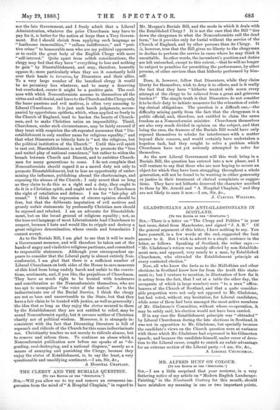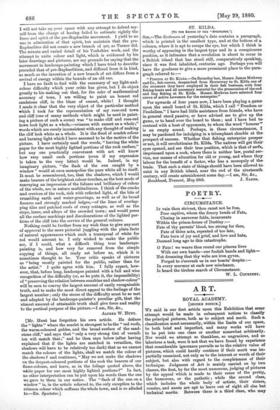MR. ALFRED HUNT ON COLOUR.
[TO TER EDITOR OF THE SPKTATOR.1
Sra,—I am a little surprised that your reviewer, in a very flattering notice of my article on "Modern English Landscape Painting," in the Nineteenth Century for this month, should have mistaken my meaning in one or two important points. I will not take up your space with any attempt to defend my- self from the charge of having failed to estimate rightly the force and spirit of the pre-Raphaelite movement. I yield to no
one in admiration of that spirit, but maintain that the pre- Raphaelites did not create a new branch of art, as Turner did.
The minute and varied detail of his Yorkshire work, and the attempt to unite colour and light, which is evidenced by his later drawings and pictures, are my grounds for saying that the movement in landscape-painting which I have tried to describe preceded that of pre-Rapha.elitism, and differed from it in kind, as much as the invention of a new branch of art differs from a revival of energy within the bounds of an old one.
I have no fault to find with the summary of my light-and- colour difficulty which your critic has given, but I do object greatly to his making out that, for the sake of mathematical accuracy of tone, I am willing to paint an honest red sandstone cliff, in the blaze of sunset, white ! I thought I made it clear that the very object of the particular method which I took for the representation of my rose-red town and cliff (one of many methods which might be used in paint- ing a picture of such a scene) was "to make cliff and rose-red town look light as a whole,—crimson with sunset as a whole ;" words which are surely inconsistent with any thought of making the cliff look white as a whole. It is the flood of scarlet colour and burning light which I have assumed to be the motive of the picture. I have certainly used the words, "leaving the white paper for the most highly lighted portions of the rock surface," but any one practically conversant with art will know. how very small such portions (even if my expression is taken to the very letter) would be. Indeed, in my imaginary picture, "the flash of the sun caught by a window" would at once monopolise the pure white all to itself. It must be remembered, too, that the shadows, which I would make bearers of the brightest colour-touches, as the best mode of conveying an impression of the fulness and brilliancy of colour of the whole, are in nature multitudinous. I think of the cracks and crevices of the rock, rich with reflected light, of the bits of crumbling earth and water-groovings, as well as of its broad fissures and strongly marked ledges,—of the lines of overlap- ping tiles and patched roofs of crazy cottages, as well as the steps, lanes, and alleys of the crowded town ; and would press all the surface markings and discolourations of the lighted por- tions of the cliff into the service of the general redness.
Nothing could be further from my wish than to give any sort of approval to the mere pictorial juggling with the plain facts of natural appearances which such a transposal of white for red would amount to. I only wished to make the public see, if I could, what a difficult thing true landscape- painting is, and how very far removed from the simple copying of things, all ready set before us, which it is sometimes thought to be. Your critic speaks of pictures as "being mostly painted for the public, rather than for the artist." I quite agree with him. I fully expect, how- ever, that, before long, landscapes painted with a full and wise recognition of the difficulty (or, as he puts it, the impossibility) of "preserving the relation between sunshine and shadow-colour" will be seen to convey the largest amount of easily recognisable truth, and to make the most direct appeal to the feelings of the largest number ; only the stress of the difficulty must be so met and adapted by the landscape-painter's peculiar gift, that the utmost amount of attainable truth shall give force and reality to the poetical purpose of the picture.—I am, Sir, Spc., ALFRED W. TIENT.
Dir. Hunt has forgotten his own article. He defines the "lights" where the scarlet is strongest to be the "red roofs, the warm-coloured gables, and the broad surface of the sand- stone cliff," and says that "only a very strong tint of vermil- ion will match that ;" and, he then says below (after having explained that if the lights are matched in vermilion, the shadows will have to be relatively too dark) that as we cannot match the colours of the lights, shall we match the colour of the shadows ? and continues, "May we not make the shadows on the deepest-coloured portions of the rock the bearers of our flame-colours, and leave, as in the foliage quoted above, the white paper for our most highly lighted portions ?" In fact, no other interpretation can be put upon his words than the one we gave to them in our notice. The "flash of the sun on a window" is, in the article referred to, the only exception to the crimson colour which suffuses the whole town, and is so alluded to.—En. Spectator.]



































 Previous page
Previous page